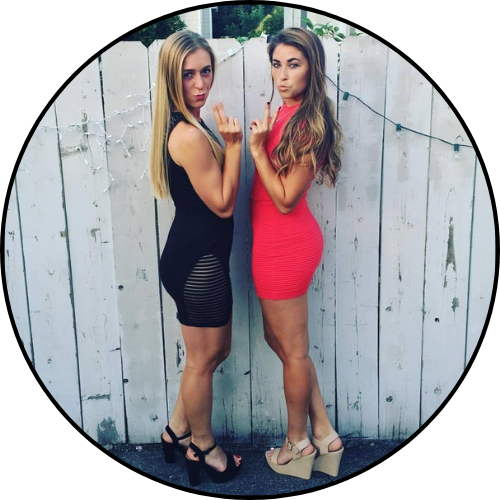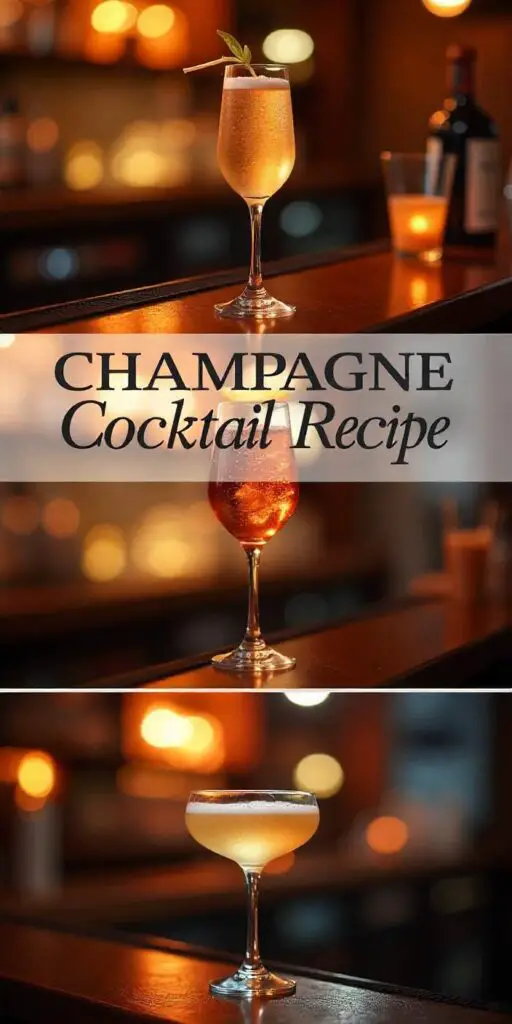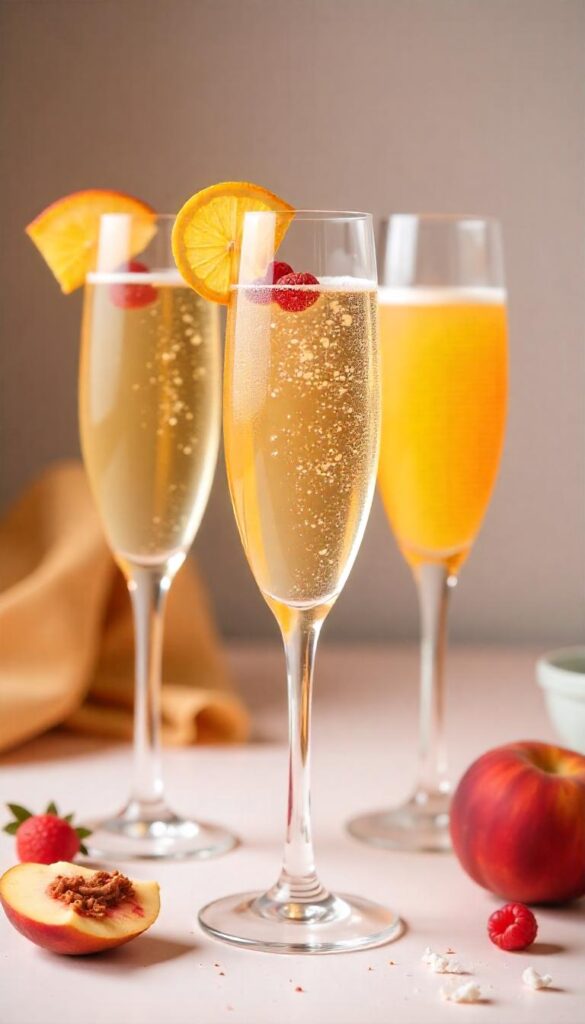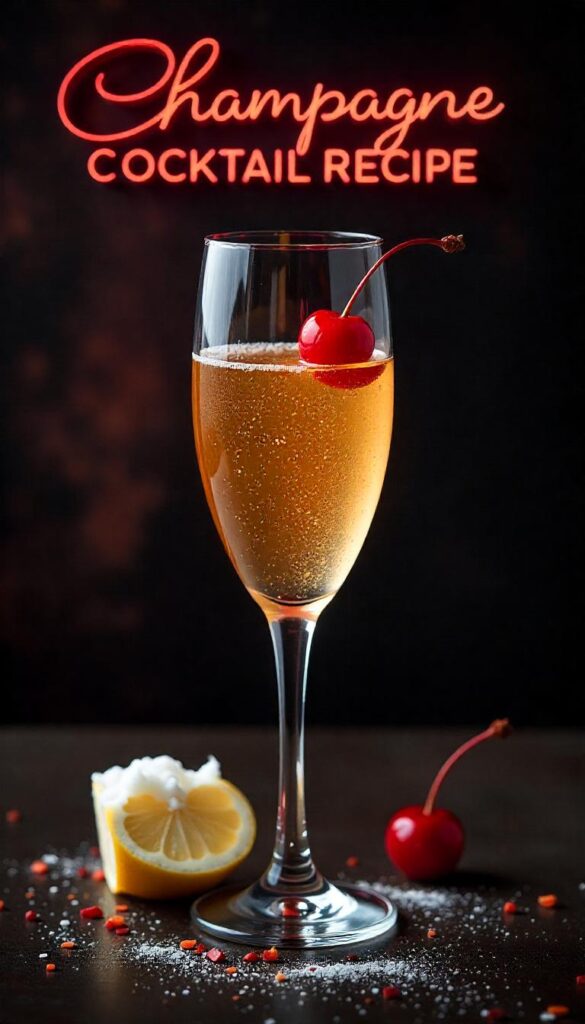When it comes to classic cocktails that exude sophistication, elegance, and a touch of celebratory flair, few drinks can rival the timeless Champagne Cocktail. This effervescent libation has graced cocktail menus since the 19th century, often associated with special occasions, romantic dinners, weddings, and New Year’s Eve toasts. It’s simple yet refined — a perfect blend of dry Champagne, a sugar cube, aromatic bitters, and a twist of citrus.
Whether you’re hosting an upscale dinner party or just want to add some sparkle to your evening, this Champagne Cocktail Recipe is a must-know. It combines ease of preparation with a flavor profile that is both refreshing and deeply aromatic. It’s a classic aperitif — a drink designed to stimulate the appetite and set the tone for the meal ahead.
This guide will walk you through everything you need to know about the Champagne Cocktail, including detailed instructions, nutritional information, and some helpful tips to perfect this timeless drink.
🕒 Recipe Overview
-
Prep Time: 5 minutes
-
Active Time: 5 minutes
-
Resting Time: 0 minutes
-
Total Time: 5 minutes
-
Servings: 1
-
Calories per Serving: ~125 kcal
-
Cuisine: French, American
-
Course: Cocktail / Drink / Aperitif
🥂 Ingredients
To make one serving of a Champagne Cocktail, you’ll need the following:
-
1 sugar cube
-
2–3 dashes of Angostura bitters
-
5 oz chilled Champagne (or any dry sparkling wine such as Cava or Prosecco)
-
1 lemon or orange twist (for garnish)
-
Optional: A dash of cognac or brandy for extra depth
Ingredient Notes:
-
Champagne: Opt for Brut (dry) Champagne to balance the sweetness of the sugar cube.
-
Bitters: Angostura is traditional, but Peychaud’s or orange bitters can be used for variation.
-
Sugar Cube: White sugar cubes work best as they dissolve slowly and interact beautifully with the bitters.
🍹 Equipment
You don’t need a full bar setup to create a Champagne Cocktail, but the following will help:
-
Champagne flute or coupe glass
-
Bar spoon or stirrer
-
Jigger (optional)
-
Paring knife or citrus peeler
🧾 Instructions
Here’s how to make a perfect Champagne Cocktail in just a few easy steps:
Step 1: Prepare the Glass
Place a sugar cube at the bottom of a chilled Champagne flute.
Step 2: Add Bitters
Saturate the sugar cube with 2–3 dashes of Angostura bitters. Let it sit for a few seconds so the sugar begins to dissolve slightly.
Step 3: Add Optional Brandy
For a more robust and richer flavor, pour in about ½ oz of cognac or brandy over the bitters-soaked sugar cube.
Step 4: Pour the Champagne
Slowly top the glass with cold Champagne. Pour gently to preserve the bubbles and avoid overflow.
Step 5: Garnish and Serve
Twist a lemon or orange peel over the top of the glass to release the oils, then drop it in or hang it on the rim as a garnish.
Serve immediately and enjoy the delicate layers of aroma and flavor.
🧠 Pro Tips
-
Glass Chill: Always chill your glassware beforehand. A cold flute keeps your cocktail crisp and bubbly longer.
-
Bitters Variety: Experiment with orange or grapefruit bitters for a modern twist.
-
Sugar Infusion: You can make flavored sugar cubes (like vanilla or lavender) to infuse new dimensions into the cocktail.
-
Don’t Stir Too Much: Stirring vigorously will flatten the bubbles. A gentle mix is all you need.
-
Batch Serving: Preparing for a party? You can pre-soak several sugar cubes with bitters and store them until serving time.
🧪 Nutrition (Per Serving)
| Nutrient | Amount |
|---|---|
| Calories | ~125 kcal |
| Total Carbohydrates | 5–7 g |
| Sugars | ~4 g |
| Fat | 0 g |
| Protein | 0 g |
| Alcohol Content | ~14% ABV |
Note: Nutritional values are estimates based on standard ingredients.
🥳 When to Serve a Champagne Cocktail
The Champagne Cocktail is an ideal choice for:
-
New Year’s Eve Celebrations
-
Wedding Toasts
-
Anniversary Dinners
-
Holiday Gatherings
-
Brunches and Afternoon Receptions
-
Romantic Evenings
It’s elegant without being fussy — the kind of drink that says “special occasion” without needing to shout it.
🔁 Variations & Twists
Looking to put a unique spin on the traditional Champagne Cocktail? Here are a few creative ideas:
1. French 77
Add elderflower liqueur (such as St-Germain) and lemon juice to the mix for a floral, zesty variant.
2. Rosé Champagne Cocktail
Swap the traditional Champagne with a brut rosé for a blush-colored beauty.
3. Spiced Champagne Cocktail
Use spiced bitters like cardamom or clove bitters and garnish with a cinnamon stick.
4. Berry Bliss
Drop a fresh raspberry or blackberry into the flute before pouring the Champagne for a fruity twist.
5. The Royale
Use crème de cassis (blackcurrant liqueur) instead of bitters for a sweet, berry-forward profile.
🧾 History of the Champagne Cocktail
The Champagne Cocktail first appeared in print in Jerry Thomas’s 1862 classic How to Mix Drinks, making it one of the oldest known cocktails. Unlike many modern Champagne drinks that are sweet or fruity, this cocktail was created as an aperitif — meant to awaken the palate, not overpower it.
Its enduring charm lies in its simplicity. The interplay between the bitter, the sugar, and the sparkling wine creates a depth of flavor that’s surprisingly complex. No wonder it was a favorite among mid-century socialites and literary figures alike (think F. Scott Fitzgerald and James Bond).
❄️ Storage Tips
-
No Storage Needed: Champagne Cocktails are meant to be made and served immediately.
-
Sugar Cubes & Bitters: You can pre-soak sugar cubes with bitters and keep them in a sealed container for a few days before use.
-
Opened Champagne: If you have leftover bubbly, use a Champagne stopper and refrigerate. Best consumed within 1–2 days.
💬 Frequently Asked Questions (FAQs)
Q: Can I use Prosecco or Cava instead of Champagne?
A: Yes! While traditional recipes call for Champagne, dry Prosecco or Cava are more affordable and work beautifully.
Q: What if I don’t have sugar cubes?
A: You can use about ½ tsp of granulated sugar. It dissolves faster, so pour Champagne slowly to preserve the fizz.
Q: Is this drink very sweet?
A: Not overly. The sugar is balanced by the bitters and the dryness of the Champagne.
Q: Can I make this non-alcoholic?
A: You can use sparkling grape juice and omit the bitters, though it won’t be quite the same. Consider adding a splash of non-alcoholic bitters or citrus extract for complexity.
📝 Final Thoughts
The Champagne Cocktail is a symbol of refinement, festivity, and charm. With only a handful of ingredients and a few simple steps, you can create a drink that feels lavish and celebratory without any of the fuss. Whether you’re raising a glass to the new year, a loved one, or simply to yourself, this Champagne Cocktail Recipe is a surefire way to elevate any moment.

I am Ashley Doyle, Senior Specialist in Food & Policy at The Humane Society of the United States and editor at airfryermama.com. I am passionate about transforming our global food system by promoting delicious, climate-friendly, plant-based foods. After transitioning from law to food and public policy, I now work with major food service companies to develop plant-based initiatives and animal welfare policies. My goal is to drive institutional change to combat climate change and improve our food system.



